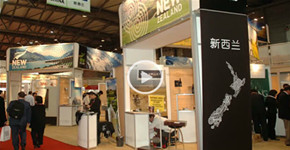Guangxi boosts ASEAN trade
By : Huo Yan in Nanning(China Daily)
2016-01-13
The countryside in Luzhai county, Liuzhou city in the Guangxi Zhuang autonomous region has become a new tourist attraction. Photos Provided to China Daily
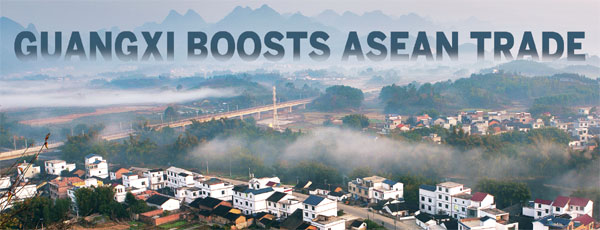
Editor's Note: The Guangxi Zhuang autonomous region, which has a long history of contact with Southeast Asia, thanks to its affinity in language, culture and customs, is set to become China's pathway to the Association of Southeast Asian Nations, forming a new strategic pivot in Southwest and Central China's opening up. China Daily spoke with Peng Qinghua, the region's Party chief, to find out more.
Q: Guangxi was an important point along the ancient maritime Silk Road. How do you define Guangxi's position in China's Belt and Road Initiative today?
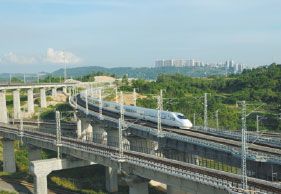
Peng: In March last year, President Xi Jinping urged Guangxi to become China's pathway to ASEAN, a new strategic pivot in Southwest and Central China's opening up, and a dynamic portal connecting the 21st Century Maritime Silk Road and the Silk Road Economic Belt.
The Belt and Road Initiative extends China's opening-up frontiers to West China and the border regions, making Guangxi a direct beneficiary.
Guangxi has a long history of contact with Southeast Asia, thanks to its affinity in language, culture and customs. More than 2,000 years ago, during the Han Dynasty (206 BC-AD 220), Hepu, a county in southern Guangxi, had shipping lines to India and Sri Lanka, and gradually developed into an important departure port on the ancient maritime Silk Road to Asia's south and southeast.
The southeast China economic circle, the South China economic circle and ASEAN's economic circle overlap in Guangxi, the most convenient outlet to the sea for Southwest China.
Q: What will Guangxi do to transform President Xi's hope into reality?
Peng: Guangxi will take the opportunity of the "Belt and Road" strategy to promote interconnectivity and further opening-up with Southeast Asia.
Guangxi is at the crossroads of the economic belt from Kunming to the Greater Mekong Subregion and the economic corridor for Bangladesh, China, India and Myanmar. The economic belt extends to Central Asia through Guiyang, Chongqing, Chengdu, Xi'an and Lanzhou, and the corridor connects Hunan, Hubei and Central China.
Guangxi will construct the Xijiang River Economic Belt and make the river a golden waterway to the Pearl River Delta, Hong Kong and Macao. Meanwhile, the construction and upgrading of the high-speed road and railway networks connecting Guangxi to the Pearl River Delta will also be speeded up.
To the ASEAN region, Guangxi will build a pathway from Nanning to the Indo-China Peninsula and an economic corridor from Nanning to Singapore. We will expedite the construction of the China-ASEAN Port City Cooperation network, which includes the Beibu Gulf ports in Guangxi.
Guangxi has an annual cargo handling capacity of nearly 250 million metric tons in its sea ports, more than 100 million tons of cargo-handling capacity in its river ports, and 35 cargo shipping lines to 45 ports in ASEAN countries. The airport in Nanning handles 10 million passenger trips a year, and has routes to 24 airports outside of the Chinese mainland. Guilin, a global tourist attraction in Guangxi, offers 72-hour visa-free transit stays for travelers from 51 countries.
By 2020, Guangxi will have more shipping lines and air routes to ASEAN countries, and more cross border optical cables to Southeast Asia.
Q: Guangxi is the permanent host for the China-ASEAN Expo. You led a delegation to Brunei, Thailand and South Korea in April to promote the expo. How did your visits go?
Peng: The expo has had 12 sessions since 2004, and more than 50 state leaders and 2,300 ministers have participated. The expo has become a window for Chinese enterprises to enter ASEAN, and a bridge for ASEAN commodities to enter the Chinese market.
I visited the three countries to promote the expo as a platform, and to explore new cooperation mechanisms.
The Brunei-Guangxi Economic Corridor is an important component of the Belt and Road Initiative. During my visit, the two sides reached agreements on port cooperation, construction of an agricultural-industrial park and a Chinese medicine industrial park, as well as cooperation in planting rice paddies and raising oysters.
During my visit to Thailand, the China-ASEAN Expo organized an exhibition of Chinese and Thai commodities and enterprises, which was warmly welcomed by locals, enhanced the expo's influence and created new platforms for Chinese corporations to enter Thailand.
During my visit to South Korea, I paid special attention to introducing Guangxi's unique strengths and opportunities in its future development, and extended a warm invitation to its entrepreneurs and investors to visit Guangxi, take part in the expo and make Guangxi a base for exploring the ASEAN market.
Q: Guangxi's foreign trade exceeded $40 billion in the first eleven months of last year, up 12.9 percent year-on-year. China's overall foreign trade declined, so how did Guangxi register such a remarkable increase?
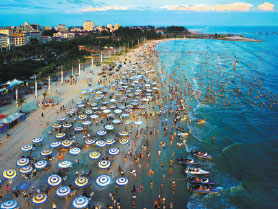
Peng: Guangxi has maintained a robust momentum in its foreign trade in recent years, rising from $23.33 billion in 2011 to $40.55 billion in 2014. Guangxi's trade with ASEAN rose from $9.56 billion to $19.89 billion. From January to November last year, Guangxi's foreign trade hit $40.12 billion, of which $20.33 billion was with ASEAN.
Strong complementarity, bright prospects and great development potential for cooperation between Guangxi and ASEAN, which were released with the construction and upgrading of the China-ASEAN Free Trade Area, constitute a solid foundation for the fast increase in trade.
The establishment of national key development pilot zones, border financial reform pilot zones and he China-Vietnam cross-border economic cooperation zone, the implementation of a series of reforms facilitating trade convenience in customs clearance, as well as the prospering of the service trade and processing industry in the border region all boosted Guangxi's trade with ASEAN.
Q: How does Guangxi cooperate with ASEAN countries industrially?
Peng: We developed a port industry cluster in the Beibu Gulf, created some cooperation platforms that included the Qinzhou bonded port area, the Pingxiang bonded area, the Nanning bonded area, the Beihai export industry zone, the Dongxing opening-up pilot zone, a border financial reform pilot zone, a China-Vietnam cross-border economic cooperation zone, the Detian-Ban Gioc tourism cooperation zone and a border opening-up economic belt. Currently, many enterprises from Indonesia, Singapore and Malaysia have set up branches in Guangxi. China-Malaysia industrial parks in Qinzhou and Kuantan in Malaysia have embraced their first batch of enterprises. The China-Indonesia economic and trade cooperation one has attracted 27 businesses so far, and the China-Thailand industrial park in Chongzuo has carried out nine cooperation programs with businesses from the two countries.
We also encouraged Guangxi businesses to go into the ASEAN market. By the end of 2014, 563 Guangxi enterprises had investments abroad, mostly in ASEAN countries, invested in almost all of their main industries. Within the first 10 months of last year, Guangxi had invested $161 million in ASEAN countries, 10 times that in the same period last year. Guangxi enterprises rely more on industrial parks as a platform in foreign countries than before.
Q: Could you describe Guangxi's cooperation with Guangdong, Hong Kong and Macao?
Peng: We pay special attention to attracting investments from those three places through various promotional activities.
Currently, 6,625 Hong Kong enterprises have invested $12.6 billion in Guangxi, accounting for nearly half of the investment from outside the Chinese mainland. Guangdong's total investment in Guangxi is more than 1 trillion yuan.
Apart from investment, these enterprises bring advanced technology and management models to Guangxi. And Guangxi's opening-up to Southeast Asia will give these Pearl River Delta enterprises more opportunities in the ASEAN market.
Q: What will Guangxi seek to accomplish in opening-up and international cooperation during the 13th Five-Year Plan period (2016-20)?
Peng: Guangxi will connect with Southeast Asia through five networks: high-speed roads, high-speed railways, ports, airports and information. Guangxi will integrate the final 20 percent of its remote counties into the high-speed railway system, make all of its cities accessible by high-speed rail and turn all of it major rivers into water transportation channels. Guangxi will continue to host the China-ASEAN Expo and the China-ASEAN Business and Investment Summit, and make efforts to make Nanning the first choice for the Asian Infrastructure Investment Bank's subcenter to ASEAN and the China-ASEAN Investment Promotion Center. Guangxi will encourage enterprises in iron and steel, construction materials, automobiles, engineering machinery and agricultural machinery to pay more attention to overseas markets and seek opportunities for capacity cooperation with foreign partners.
Guangxi will open more fields for foreign investment through the "negative list" model, further simplify the procedures for customs clearance, open more service sectors to partners from Hong Kong and Macao, promote e-commerce in the ASEAN market, increase cultural exchanges and communications between young people.
Q: How will Guangxi eliminate poverty by 2020, as required by the central government?

Peng: By the end of 2014, 5.38 million rural residents in Guangxi lived on less than $1.25 a day. The government organized 250,000 grassroots civil servants to visit each of these families to understand their practical difficulties and conditions.
Heads of governments at various levels take the main responsibilities for poverty alleviation, and their performance will be judged on their accomplishments. The government will help to develop home workshops and e-commerce, create jobs for the poor, relocate people living in inhospitable places, provide a special ecological compensation fund for poor people living in places with a fragile ecology to dissuade them from developing polluting industries, improve education and medical care for the needy and promote border trade. The government should cover the poor with a basic welfare net, and provide free vocational training and loan-interest subsidies to arm poor farmers with skills and funding.
Li Yang in Beijing contributed to this story.
huoyan@chinadaily.com.cn
Quick Biography
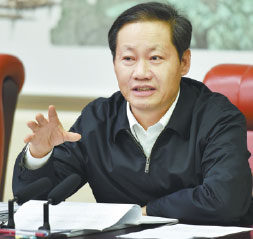
Name: Peng Qinghua
From: Born in 1957 in Daye, Hubei province
Education: Graduated from Peking University in 1983 with a bachelor's degree in philosophy
Employment: He worked in the Organization Department of the Central Committee of the Communist Party of China from 1983 to 2003, and the Liaison Office of the Central Government in the Hong Kong Special Administrative Region from 2003 to 2012 before serving as Party chief of Guangxi.
Source: Guangxi government
Guangxi at a glance
The Guangxi Zhuang autonomous region covers an area of 236,700 square kilometers, roughly three-quarters the size of Scotland, and has a population of about 47.54 million. Guangxi's gross domestic product in 2014 was $260 billion, similar to that of Ireland. Guangxi is well-known in China for its ethnic culture, fresh fruit and seafood, and beautiful natural vistas.
Guangxi borders Vietnam and has three big ports - Qinzhou, Beihai and Fang chenggang - on the Beibu Gulf coastline. They are important bases for Guangxi's trade with Southeast Asia and its development of emerging industries.
The picturesque Karst landscape in northern Guangxi has made Guilin a household name in China.
The cities of Hechi, Chongzuo and Baise in the west have rich nonferrous metal resources, and are home to many ethnic groups of people, including the Zhuang, Miao, Yao and Dong. Nanning and Liuzhou are political and industrial centers, respectively. Liuzhou produces more than 2 million automobiles a year, and is the fifth largest auto manufacturing city in China. The cities of Hezhou, Wuzhou and Yulin in the east of Guangxi, bordering Guangdong province, are home to millions of migrant workers.
Source: Guangxi government
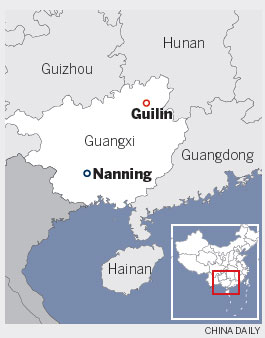
(China Daily 01/13/2016 page7)

